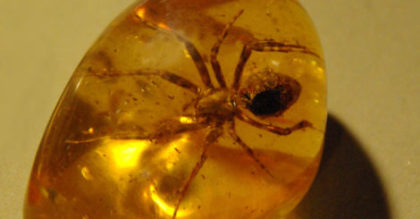
 )
)I imagine we could also use a break from the science story that is dominating headlines, so let’s dig a little deeper for something else to talk about: fossils. There were a pair of stories about discoveries encased in amber. Both are dated around 99 million years old and come from Myanmar. (You can read more about the recent boom in Myanmar amber and its complicated ethics.) One of the fossils is a tiny dinosaur, likely from the branch of the dinosaur family tree that gave us modern day birds. The other fossil is perhaps less appealing–a cockroach caught in or recently after the act of eliminating–but for a certain kind of scientist it is a rare and exciting find, and I think it’s pretty cool that the scientific community is as diverse in its interests as the tree of life is in its offerings.
I also think it’s pretty cool that we have access to these miniature biological time capsules. We’ll never be able to construct a complete picture of Earth’s past, but given the phenomenal span of time involved, I think it’s remarkable that we can know anything at all. Even better, we have multiple ways of knowing. More familiar types of fossils, the mineralized skeletons and impressions of bygone creatures, tell part of the story. But they skew towards larger specimens, at least partly because the processes of both making fossils and extracting them can be hard on delicate features. Since amber is fossilized tree resin, it comes in small portions; and it provides more protection for its contents. So amber is great for preserving tiny specimens like insects and very small dinosaurs. Even better, it preserves more of those creatures than just their skeletons, so features like the eye opening can be examined.
Amber can even preserve specimens too tiny to see unaided, like the bacteria and protozoa discovered along with the cockroach and its deposit. I imagine for many of you microorganisms from the gut of a cockroach are among the few things even less appealing than the cockroach itself. But recall that cockroaches are close relatives of termites, and the bacteria in modern-day termite guts are of great interest among biofuel researchers. Now, I wouldn’t expect these microbial fossils to single-handedly resolve our renewable energy needs. But one of the big challenges in termite-based biofuels is teasing out the complicated interactions between microbes and termites and among the multiple microbial species. Collectively they appear to form an n-way symbiosis, making it difficult to identify metabolic pathways that can be isolated and simplified for large scale applications. Termites (or their cockroach relatives) from 100 million years ago may have simpler relationships with their microbiome that could provides hints towards a solution. It would be a fun twist if a fossil helped us reduce our dependency on fossil fuels.
Andy has worn many hats in his life. He knows this is a dreadfully clichéd notion, but since it is also literally true he uses it anyway. Among his current metaphorical hats: husband of one wife, father of two teenagers, reader of science fiction and science fact, enthusiast of contemporary symphonic music, and chief science officer. Previous metaphorical hats include: comp bio postdoc, molecular biology grad student, InterVarsity chapter president (that one came with a literal hat), music store clerk, house painter, and mosquito trapper. Among his more unique literal hats: British bobby, captain’s hats (of varying levels of authenticity) of several specific vessels, a deerstalker from 221B Baker St, and a railroad engineer’s cap. His monthly Science in Review is drawn from his weekly Science Corner posts — Wednesdays, 8am (Eastern) on the Emerging Scholars Network Blog. His book Faith across the Multiverse is available from Hendrickson.

Leave a Reply